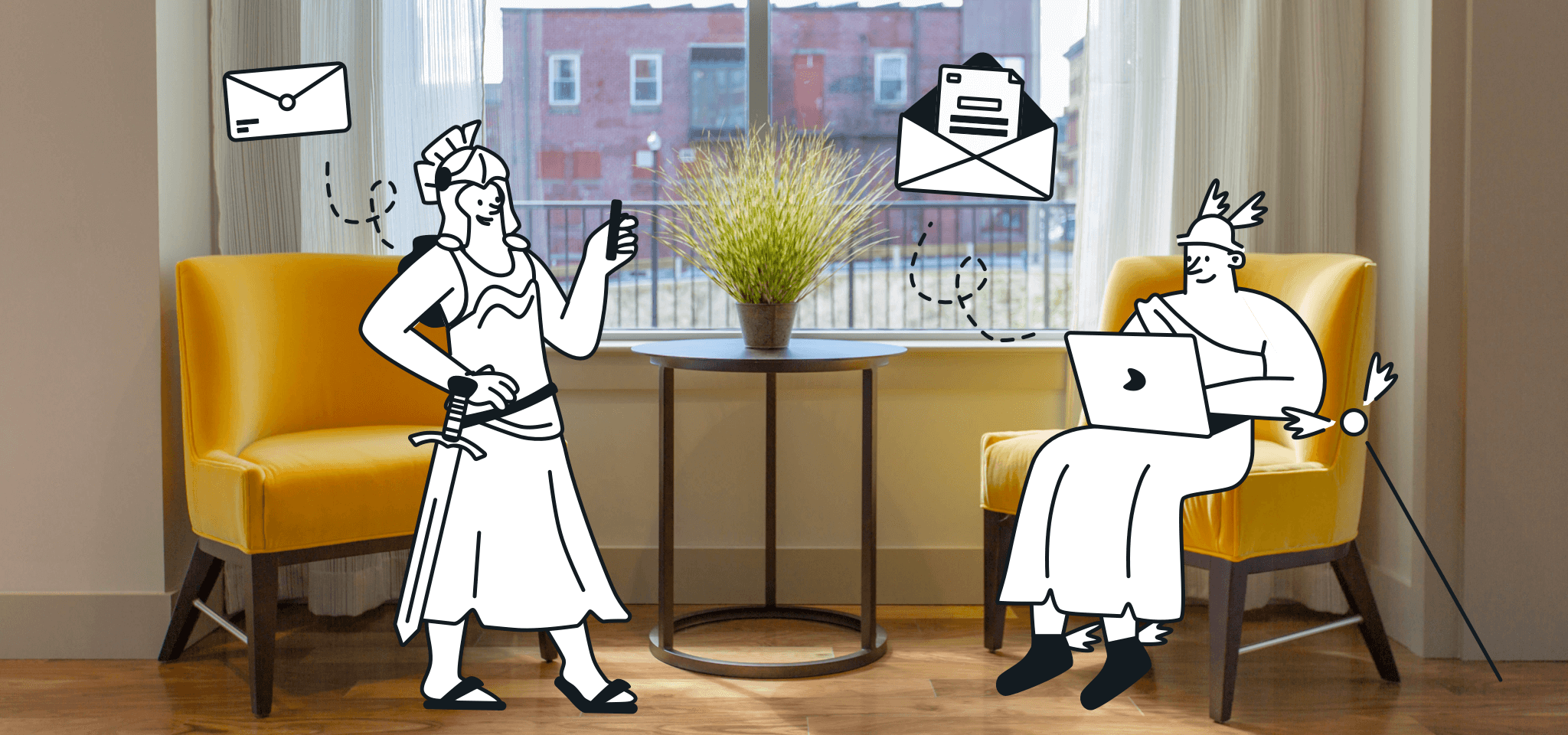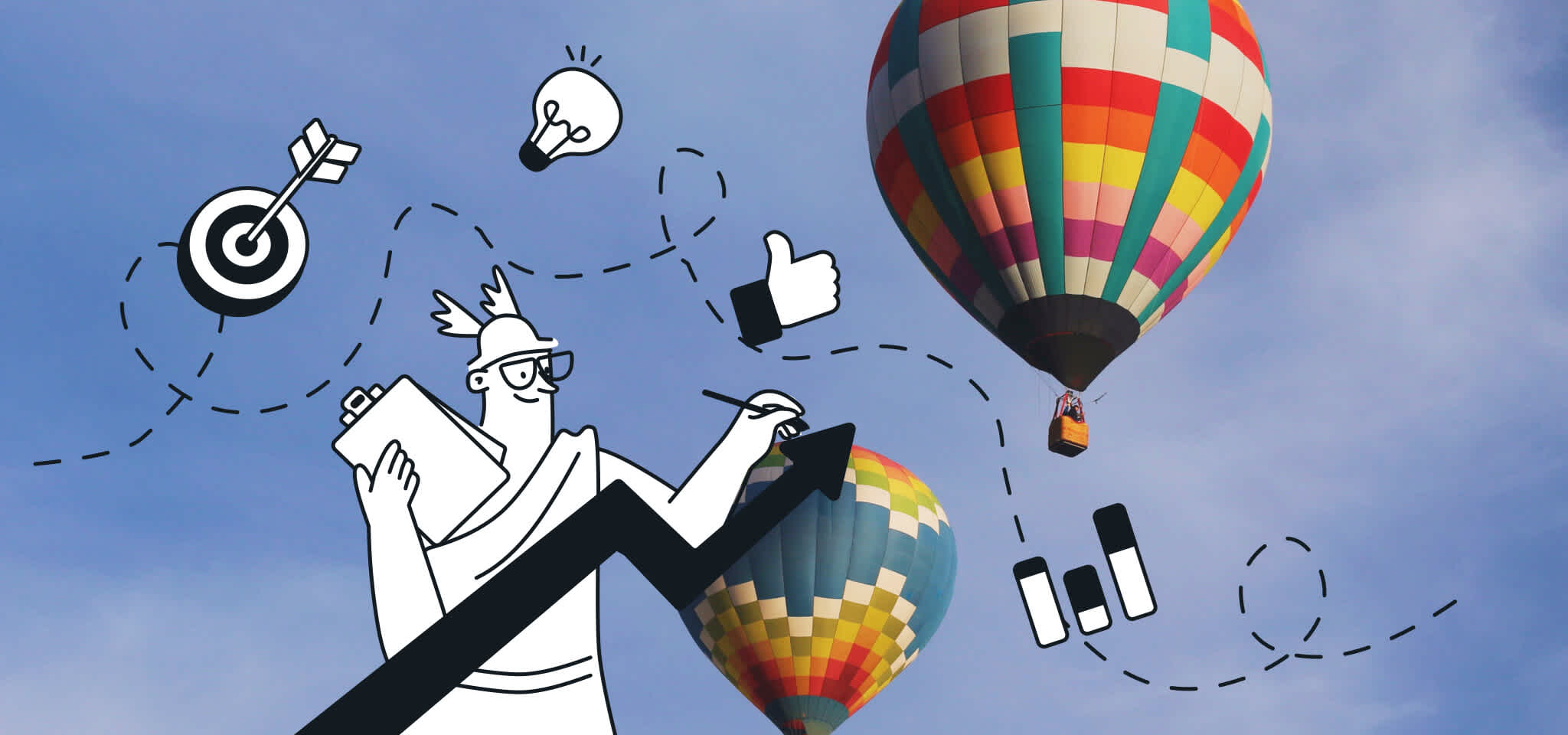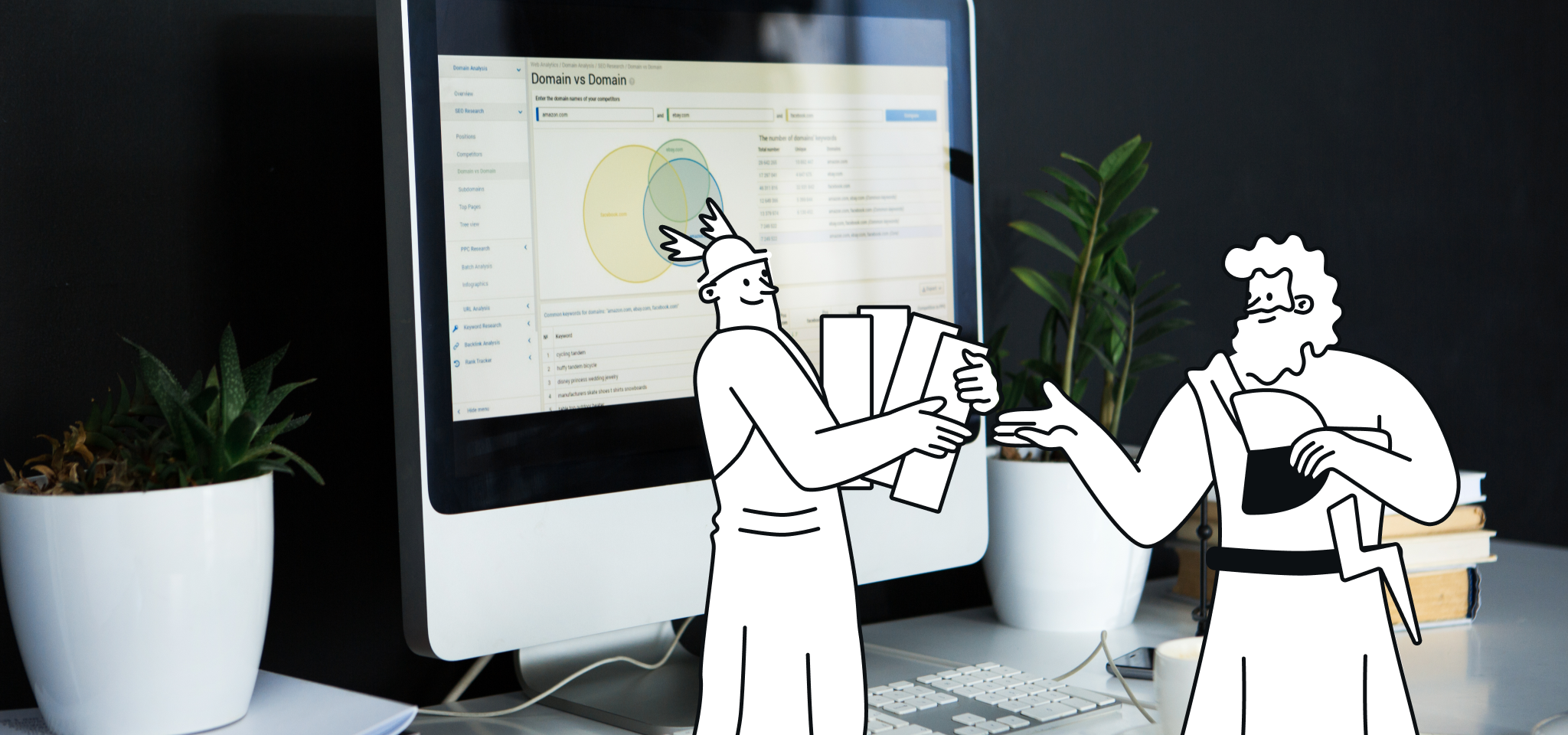Home
The Mailjet Blog
Email best practices
Email Cadence Best Practices: 9 Ideas To Increase Engagement
Email best practices
Why a consistent email cadence matters
When do you decide to send an email to your list? Is it when you have something to offer them? When you have something to sell or promote? Or, do you send emails when you planned to send them, because you committed to sending emails consistently?

PUBLISHED ON
With summer coming, it can be tempting to slack off on your email marketing. Maybe you wonder if your customers check their inbox as much during the summer. With more vacations, a few major holidays, and a general feeling of increased leisure, you may be feeling like sending fewer or no emails in the coming months.
That would be a big mistake.
A consistent email marketing cadence is proven to be more effective and generate more loyalty because of three main reasons: It helps you maintain a strong deliverability, it keeps your brand top of mind, and it provides regular engagement and revenue. Want to know more? We’ve got you covered.
You should send consistent emails because your subscribers need to hear from you. Not only when you have something to sell.
Table of content
Consistency is key to deliverability
Consistency is key to engagement
Consistency is key to revenue
Weekly newsletters
Targeted product recommendations
Use cases and tutorials
Testimonials
Event promotions
Guest content
Nurturing email series
Funny emails
Personality emails
The importance of keeping a consistent email cadence
Your email cadence is the frequency and rhythm with which you send your email campaigns. So, what should that cadence look like? What is the optimal number of emails to send? Should you send emails even if you have nothing to promote?
These questions aren’t actually the best way to think about email marketing. Email isn’t only about promotions and news. Email is, fundamentally, about staying connected and solving problems, and the frequency of emails with which we send our emails plays a big role.
For most companies, email is a relationship, not a news source or place to shop. In other words, unless they’re opening up their Google promotions tab, most people don’t read emails to go shopping. They read them to learn, to find solutions to problems they’re dealing with, to stay connected and informed, and to meet needs.
Think of your brand as a resource. You should send consistent emails because your subscribers need to hear from you – not only when you have something to sell. You are giving answers and offering opportunities your customers and subscribers want and need.
What value could your products and services bring to the lives of your potential customers? Speak to that value, in some way, and your subscribers will stay engaged.
Your goal should be to consistently touch on different stages of the customer journey. Emails about awareness will be very different from emails targeted at renewal, which will differ still from emails focused on conversion. As you plan out an email content calendar, including for the summer, try to hit on all aspects of the customer journey at regular intervals.
We’ll share several ideas in a moment to help you plan out an email sending calendar.
But first, let’s look at why sending emails consistently benefits your business.
Consistency is key to deliverability
When you only send emails sporadically, it eventually hurts your email deliverability. There are several reasons why.
ISPs normally monitor and build sender reputation based on the last 30 days. With infrequent sends, your sending habits may look more suspicious to these ISPs, and increase the chances of you getting placed in the spam folder.
Infrequent emails also lead to subscribers forgetting about your brand. Then, when they suddenly hear from you again and don’t recognize you, they are more likely to report you as spam. Spam complaints result in diminished deliverability.
As more people forget about you, your open rates will start to go down. This type of negative engagement is considered a red flag for ISPs, which might start doubting your messages are really wanted. Your emails will start going straight to the spam folder, and while this technically still counts as being delivered, most people don’t open emails from their spam folders.
If you’re worried about sending too many emails, test different sending frequencies and segment your contact list based on engagement. You might be able to target those that always open and click on your messages weekly or even daily emails, but you’ll want to send less frequently to those who don’t.
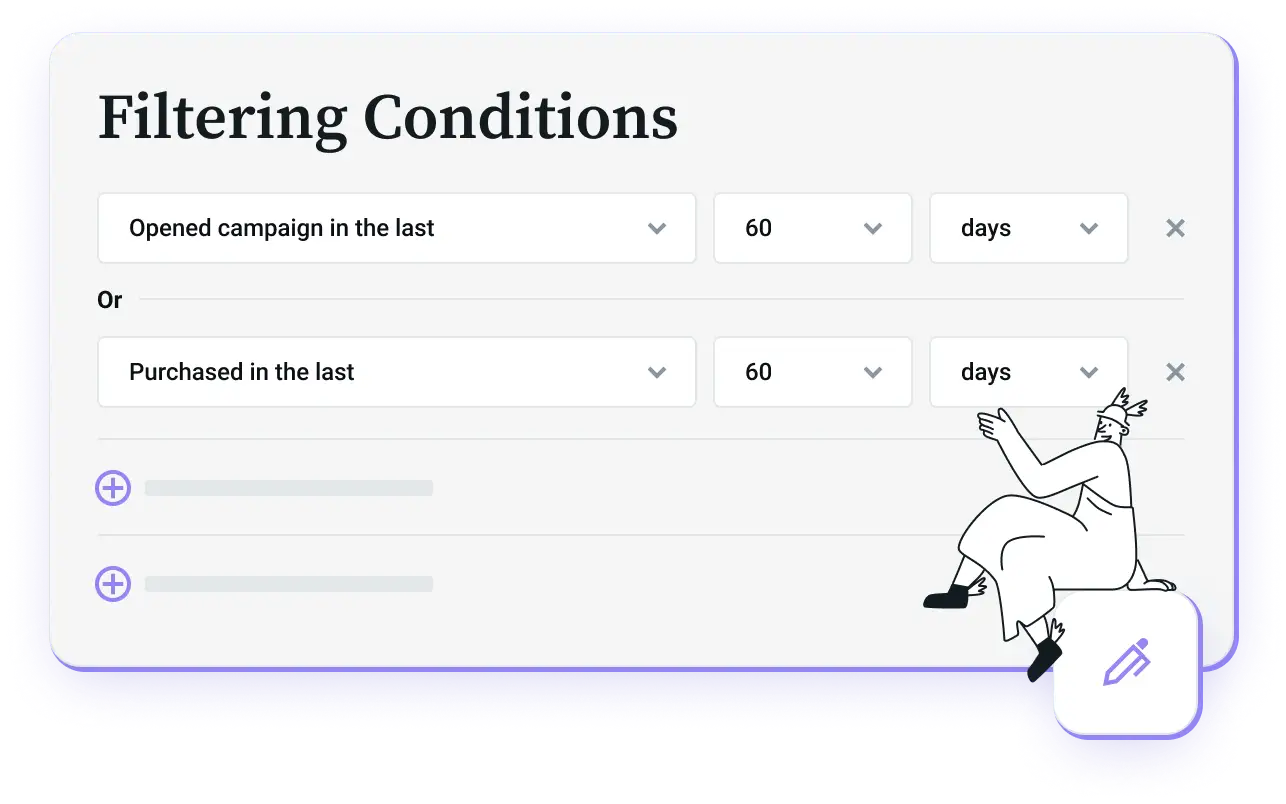
With Mailjet’s Segmentation you can create subscriber segments based on engagement to find the right frequency for each.
Consistency is key to engagement
Even if most subscribers don’t mark you as spam, the lower open and click-through rates rates you earn will obviously mean lower engagement. As you slip further back in subscribers’ minds, your attempts to re-ignite and sustain interest in your products after being silent for the summer months will be much more challenging.
One of the benefits of a consistent sending frequency is that it helps you keep your company top of mind with your prospects and clients. It also helps you build an engaged relationship with them, so that when they have a need for your products and services, they think of you first.
When subscribers begin asking themselves, “Why is this company sending me emails?”, you’ve already lost them. And when you send infrequent emails, this is what happens.
Consistency is key to revenue
With lower deliverability and reduced engagement, it’s not hard to see why this will impact your revenue. And even for people who do open your infrequent emails – if they’re only hearing from you every few months – your emails will have a harder time motivating a purchase.
Getting someone to click and buy requires timing as well as relevance. What might have been relevant last month may not matter anymore to a subscriber. But if you’re only sending emails every couple months – when you have something to say – you missed the window of opportunity for many of your subscribers.
Remember: Consistent and frequent email sendings are key to protect your email deliverability, to maintain an engaged relationship with your subscribers, and to drive revenue from email.
9 ideas to maintain a consistent email frequency during the low season
Do email open rates really drop during the summer? One statistic reports they drop from around 21% to 19% during June, July, and August. So yes, it’s a drop, but it’s not very much. Most people work the majority of the year and summer vacation habits often differ around the world. Yes, routines will change for people with kids, but they still have to eat, go places, do fun things, pay the bills, and grow professionally.
Your products and services still matter in the summer months. So don’t stop emailing.
People may shift a bit in how they use their time, and there are, perhaps, more interruptions. You could make a case for developing a unique summer email marketing strategy, but it shouldn’t include much of a drop in your email frequency.
Here are nine types of emails to keep your email frequency consistent:
Weekly newsletters
A weekly newsletter can encompass several topics at once, including many of the content ideas that will follow on this list. This is also the place for updates about your business, new opportunities for customers to engage, links to blog articles, new product announcements, and more.
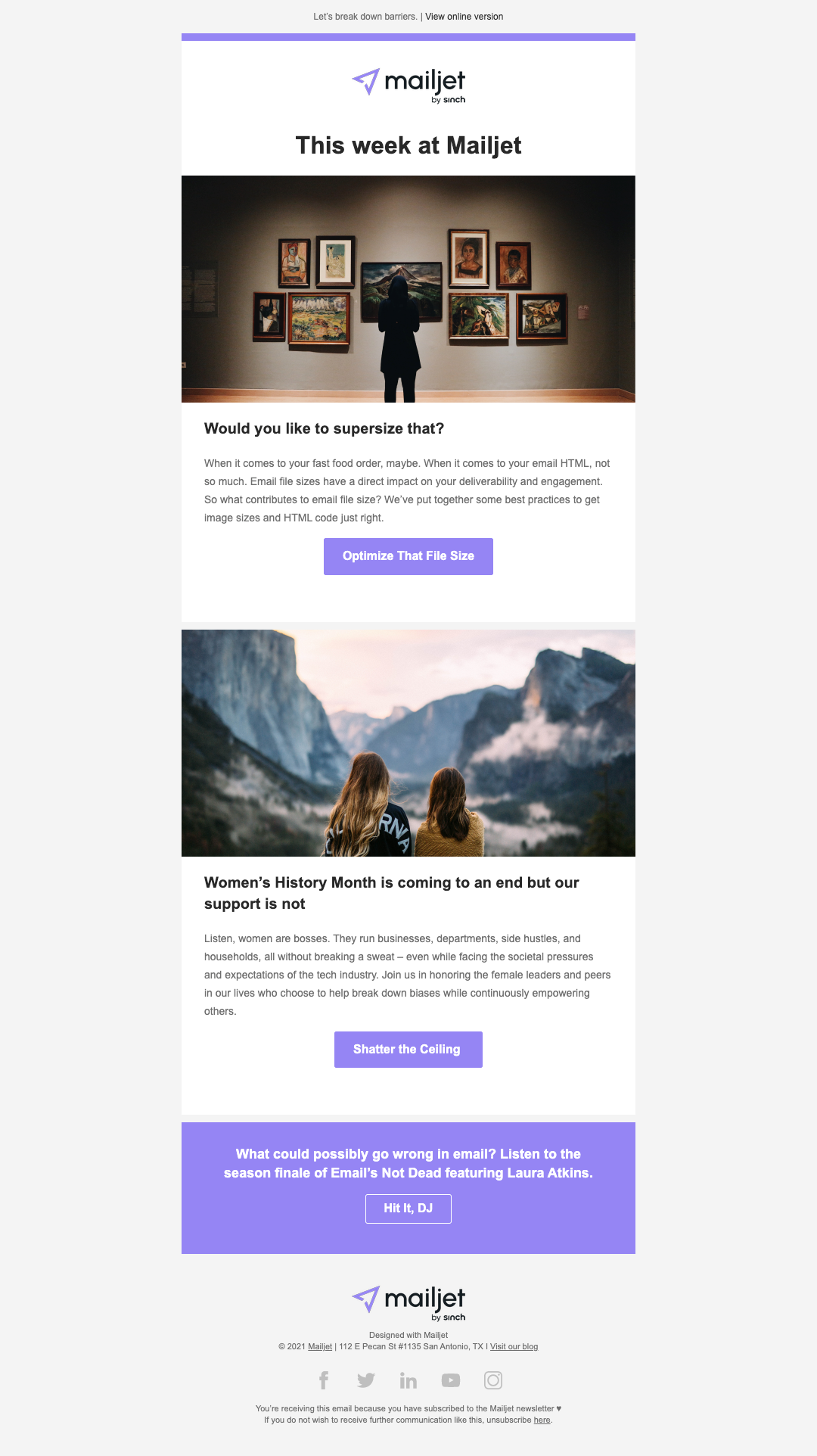
At Mailjet, we send regular newsletters with our most recent articles and resources.
Email newsletters work best when they employ proven strategies for design, content, calls to action, and other ways of engaging.
Targeted product recommendations
Hopefully, you have already created segments based on previous purchases and other forms of engagement. If you know which subscribers are interested in certain product categories or services, send relevant sales emails or promotions only to those subscribers.
Relevance perpetuates engagement. Even if they don’t buy, they’ll still appreciate the offer since this is something that matters to them.
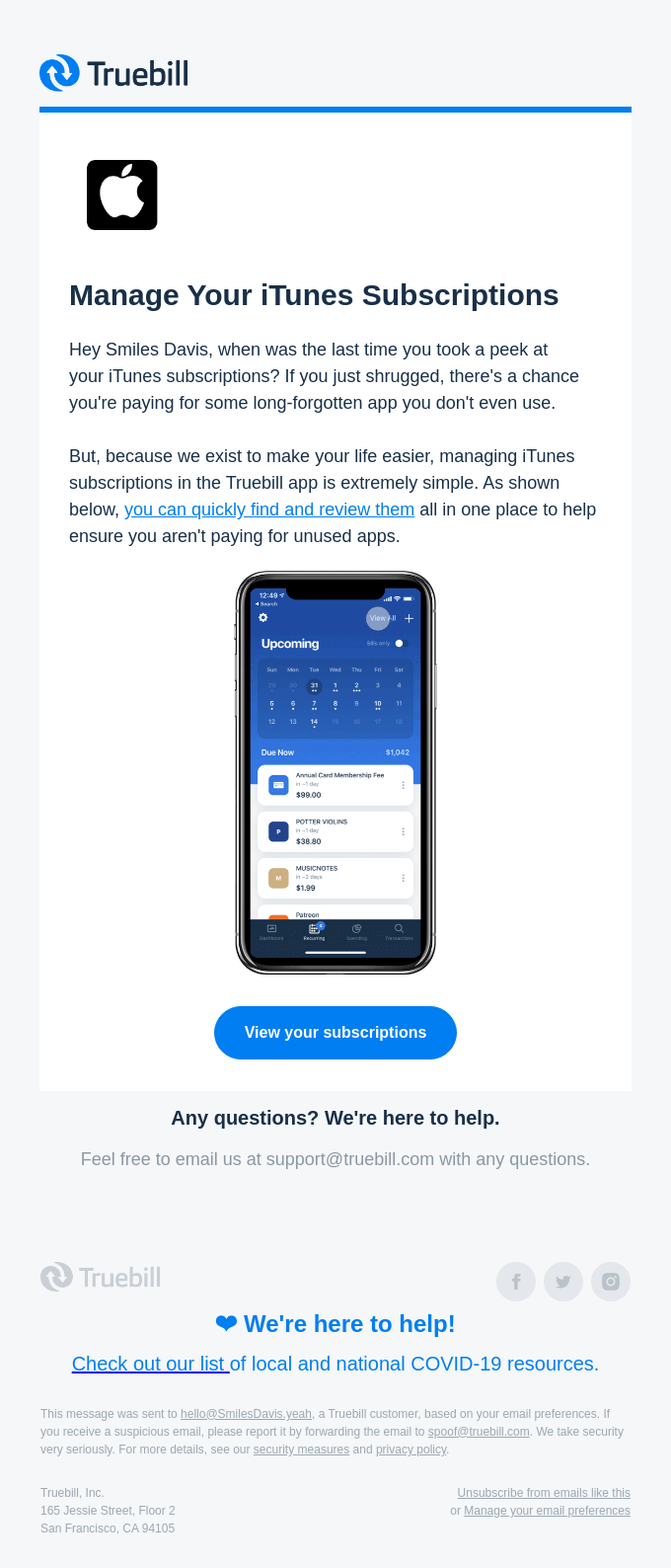
Truebill showcases how their services can be used daily.
Another targeted approach is to use summer holidays and special events. These can vary by region and don’t always need to be a major holiday. For example, in the United States, you could relate your brand to Flag Day, if appropriate. It’s not the first thing Americans think of when you say, “summer holiday”, but if it works for your brand, it works.
And again, your use of holidays doesn’t have to mean making a sale or closing deals. You might just send a message expressing something about the holiday, and nothing more.
Remember: Consistent engagement leads to revenue, but not every email has to make sales.
Use cases and tutorials
What are some common problems and challenges customers face when using your products or services?
Create content to help work through these difficulties. This isn’t selling anything, but it positions you as a helpful resource who wants your customers’ lives to be happier, easier, simpler, less stressful, more enjoyable, more fulfilled, or whatever other benefits arise from your value proposition.
These kinds of emails build customer loyalty, promote product adoption, and increase positive reception to sales and promotional emails that come later.
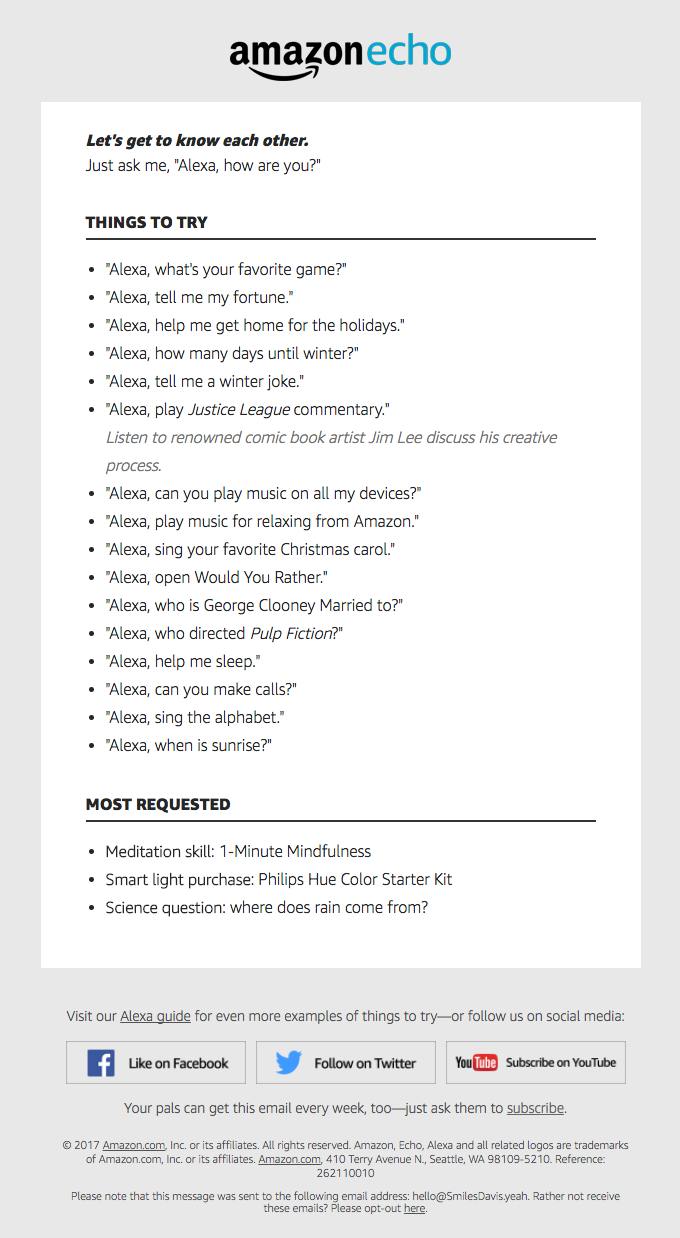
Alexa’s welcome email series shows users how to make the most of their new device.
Testimonials
Customer testimonials make great emails. Everyone likes to hear about satisfied customers when it concerns a product or service they have interest in – that’s ultimately what makes review sites so successful.

Fetching Fields promotes their products in a fun way with a testimonial from a dog and its human.
Just remember, there’s a level of quality to testimonials, especially in the world of deepfakes.
Full names are better than first names. Job titles, cities of residence, and other identifiers are better than just names. Photos are better than just text. Videos are the best of all.
The more authentic the testimonial, the more power it will have to influence.
Event promotions
If you have any events coming up, that’s an easy source of email content. And not just one email. If you want your event to succeed, you need to send several emails about it. The bigger the event, the sooner you need to start promoting it.

If you’re hosting an online event like Slack, don’t forget to add clear CTAs to register and join.
Guest content
Have a joint venture or partnership opportunity with a non-competing business? Did you meet someone at a networking event who might be able to offer helpful advice or expertise for your subscribers?
Let them write a few emails to your list sharing their expertise. Just make sure your subscribers will want to hear about this, any promotional offers are relevant, and make sure you introduce the guest in the email.
Nurturing email series
Subscribers need encouragement, and any email strategy’s goal should be to provide that.
Pretty much any business can send emails with the objective to make subscribers feel like they have someone in their corner. You are with them. You want them to succeed, be happier, get smarter, make more money, advance in life and career – whatever relates to the core benefits of your products and services.

In this re-engagement email, CLEAR shows that their services improved greatly since the recipient last used them.
The key to a great email nurture series is to send the right emails, with the right cadence, to the right people so you can push them down the funnel and along the customer journey. Email automation tools can help you deliver that experience, but ultimately it comes down to really understanding what your subscribers need to take the next step and finding the best touchpoints to deliver that.
Funny emails
Summer, especially, is the time for leisure.
If your brand voice allows for it, find a way to send humorous email content where the entire goal is simply to get a laugh. It might be a funny customer story. It could be a GIF that relates somehow to your business or your customers’ needs or frustrations. Funny photos, light-hearted stories – look for humor that your audience will appreciate.

On April Fool’s Day this year, Notes From the Dev sent out this MySpace email.
Even just one humorous email will go a long way to build a different type of connection with your audience. Just be sure to stay away from offensive topics.
Personality emails
For many businesses, customer loyalty is less about the products and more about the owner, the founder, or their internal subject matter experts. People buy because they like the person who’s selling. If there’s a face and a personality to your company who your customers know, like, and trust, some emails can just feature that person sharing their thoughts and observations about…almost anything.

Our lead email developer Megan Boshuyzen is the face of Notes From the Dev, Sinch Email on Acid’s developer newsletter and video series.
Keep your audience engaged with a consistent email cadence
Growing your business and making money through email doesn’t happen with ‘flash in the pan’ marketing. This isn’t a sprint. It’s a long-term strategy that produces consistent revenue if you use it to its full potential.
Keep on top of your email analytics. Pay attention to things like send times, sending frequency and its effect on engagement, and subject lines that seem to get more response. Know what’s working well, and keep using all the tools at your disposal from Mailjet to keep your subscribers engaged and your revenue growing.
Need more help and inspiration? Our Email Growth Playbook gives you specific tactics to use to grow your email list, design beautiful templates for your email marketing campaigns, increase engagement, and improve your chances of getting into the inbox.



